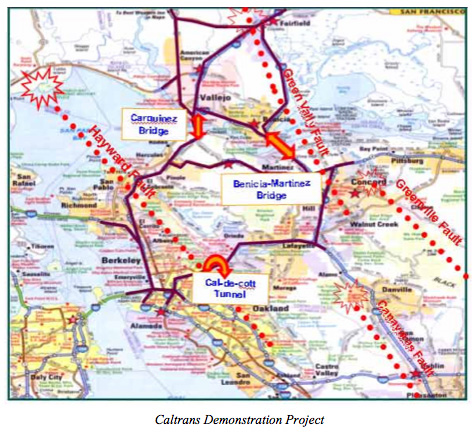Tri-Center Collaboration on Geographically Distributed Systems - 2532005
| Project Title—ID Number | Tri-Center Collaboration on Geographically Distributed Systems - 2532005 |
| Start/End Dates | 10/1/05 – 9/30/06 |
| Funding Source | PEER-CA State Transp. Fund |
| Project Leader (boldface) and Other Team Members | Jack Moehle (UCB/F) |
Project goals and objectives
The goal is to enhance PEER research in geographically distributed networks by strategic planning and collaboration with other earthquake centers.
Role of this project in supporting PEER's mission (vision)
This project will improve capabilities in modeling geographically distributed networks and will enable simulation of performance of those networks. In so doing, PEER will be able to (a) measure performance of a network and (b) identify impacts of individual component performance on the overall system. Both of these outcomes support PEER's mission in PBEE.
Methodology employed
PEER has established a joint coordination committee hired a consultant (Dr. Ron Eguchi) to assist in strategic planning and program management. PEER also supports various workshops, including participation of PEER researchers as needed.
Brief Description of previous year's achievements, with emphasis on accomplishments during last year (Year 8)
This is an ongoing project involving joints strategic planning activity with MCEER and MAE aimed at defining the areas of mutual interest and collaboration related to research in geographically distributed networks. We jointly formed a Tri-Center Coordinating Committee on Network Systems (TC3NS) to manage on-going research collaborations between the centers. Members are the Directors from each center (M. Bruneau, J. Moehle, A. Elnashai), the Deputy Directors (G. Deierlein, A. Filiatrault), the Technical Director of the MCEER-FHWA program (I. Buckle), and a representative of the PEER-Lifelines program. This year a joint research workshop was convened among key researchers to discuss available bridge fragilities and methodologies for their computation.
Work in this project contributes to the CALTRANS REDARS Demonstration Project, which is assessing the seismic performance of a portion of the highway network in Northern California.

Other similar work being conducted within and outside PEER and how this project differs
This project coordinates work being done in PEER, MAE, and MCEER.
Describe any instances where you are aware that your results have been used in industry
Results from this collaboration are being used by Caltrans as it develops a model to study the expected performance of a northern Bay Area transportation corridor.
Expected milestones & deliverables
Various research reports by PEER-funded researchers.
Member company benefits
Caltrans is involved in various project meetings and receives products for implementation in bridge design and assessment work.
Back to Funded Project Archive main page

